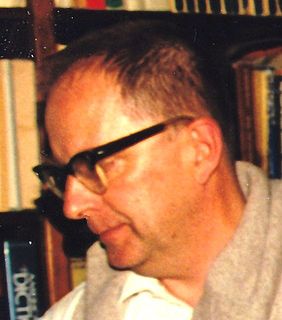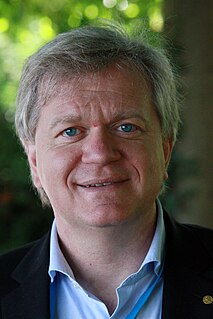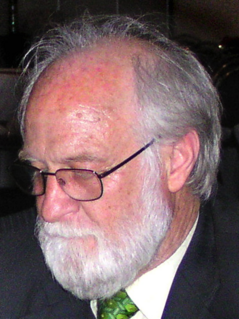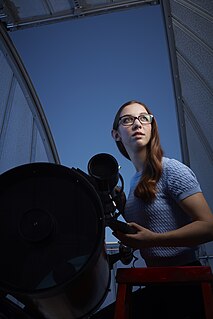Ray Norris is an astrophysicist and science communicator, based at the CSIRO Australia Telescope National Facility, and Western Sydney University, and conducts research in astrophysics and Aboriginal Astronomy.
Contents

Ray Norris is an astrophysicist and science communicator, based at the CSIRO Australia Telescope National Facility, and Western Sydney University, and conducts research in astrophysics and Aboriginal Astronomy.

Ray Norris was born in London and grew up in Brookmans Park, Hertfordshire, England in 1953. He attended high school at St. Albans School and then went to Cambridge University, where he received an honours degree in theoretical physics.
He then went to the Jodrell Bank Observatory of the University of Manchester where he received his PhD in radio-astronomy in 1978, working on astrophysical masers. At the same time, he started to develop an interest in the archaeoastronomy of Stonehenge and other megalithic observatories, joined a group of students led by Clive Ruggles and spent several years surveying the stone circles of the British Isles.
He moved to Australia in 1983 to work for the CSIRO Australia Telescope National Facility. He was appointed as head of astrophysics in 1994, and deputy director in 2000. In 2001 he led the successful bid for Australian astronomy under the Australian federal government’s “Major National Research Facilities” program, and then became director of the Australian astronomy MNRF. In 2005 he resigned from management positions to return to research. In 2013 he retired from CSIRO but was appointed as a CSIRO Honorary Fellow. In 2015 he was appointed as a Research Professor at Western Sydney University.
In 2011, Norris published his first novel, Graven Images. [2]
Norris is well known for his work on Aboriginal Astronomy, [3] and was an adjunct professor in the department of Indigenous Studies at Macquarie University. His work has featured in many radio and TV programs, including ABC TV's Message Stick, [4] and ABC Radio National's The First Astronomers. [5] In August 2009 he featured in a two-man The First Astronomers show with Wardaman elder Bill Yidumduma Harney at the Darwin Festival. [6] [7] In 2009 he published the book Emu Dreaming with his wife, Priscilla Norris
From 2000 to 2005 Norris led the Australia Telescope Large Area Survey (ATLAS) project, [8] imaging the faintest radio galaxies and star-forming galaxies in the universe, to understand how they form and evolve.
In 2009 he led a team that proposed the EMU project, operating on the new ASKAP telescope to survey of the sky at radio wavelengths, and led the EMU project until he stepped down in 2020. He also researches cosmology and dark energy. [9]
In 2020 he led a team that discovered previously unknown circles of radio emission in the sky, which they called Odd Radio Circles.

Radio astronomy is a subfield of astronomy that studies celestial objects at radio frequencies. The first detection of radio waves from an astronomical object was in 1932, when Karl Jansky at Bell Telephone Laboratories observed radiation coming from the Milky Way. Subsequent observations have identified a number of different sources of radio emission. These include stars and galaxies, as well as entirely new classes of objects, such as radio galaxies, quasars, pulsars, and masers. The discovery of the cosmic microwave background radiation, regarded as evidence for the Big Bang theory, was made through radio astronomy.

Bohdan Paczyński or Bohdan Paczynski was a Polish astronomer notable in the theory of the stellar evolution, accretion discs, and gamma ray bursts.

The Parkes Observatory is a radio telescope observatory, located 20 kilometres (12 mi) north of the town of Parkes, New South Wales, Australia. It was one of several radio antennae used to receive live television images of the Apollo 11 Moon landing. Its scientific contributions over the decades led the ABC to describe it as "the most successful scientific instrument ever built in Australia" after 50 years of operation.

The Square Kilometre Array (SKA) is an intergovernmental radio telescope project being planned to be built in Australia and South Africa. Conceived in the 1990s, and further developed and designed by the late-2010s, if built it will have a total collecting area of approximately one square kilometre sometime in the 2020s. It would operate over a wide range of frequencies and its size would make it 50 times more sensitive than any other radio instrument. It would require very high performance central computing engines and long-haul links with a capacity greater than the global Internet traffic as of 2013. Initial construction contracts began in 2018. Scientific observations of the fully completed array is not expected any earlier than 2027.

This article is on the astronomer John Bolton. For other people named "John Bolton," see John Bolton (disambiguation).

Ruby Violet Payne-Scott, BSc (Phys) MSc DipEd (Syd) was an Australian pioneer in radiophysics and radio astronomy, and was the first female radio astronomer.

Brian Paul Schmidt is the Vice-Chancellor of the Australian National University (ANU). He was previously a Distinguished Professor, Australian Research Council Laureate Fellow and astrophysicist at the University's Mount Stromlo Observatory and Research School of Astronomy and Astrophysics. He is known for his research in using supernovae as cosmological probes. He currently holds an Australia Research Council Federation Fellowship and was elected a Fellow of the Royal Society (FRS) in 2012. Schmidt shared both the 2006 Shaw Prize in Astronomy and the 2011 Nobel Prize in Physics with Saul Perlmutter and Adam Riess for providing evidence that the expansion of the universe is accelerating, making him the only Montana-born Nobel laureate.
Australian Aboriginal astronomy is a name given to Aboriginal Australian culture relating to astronomical subjects – such as the Sun and Moon, the stars, planets, and the Milky Way, and their motions on the sky.
Harvey Raymond Butcher III is an astronomer who has made significant contributions in observational astronomy and instrumentation which have advanced understanding of the formation of stars and of the universe. He received a B.Sc. in Astrophysics from the California Institute of Technology in 1969, where he contributed to the development of advanced infrared spectrometry applied in the first survey of the sky at infrared wavelengths.

Ronald David Ekers FRS FAA is an Australian radio astronomer. His fields of specialty include the study of active galactic nuclei, cosmology, and radio astronomy techniques.

Bill Yidumduma Harney is an elder of the Wardaman people, whose traditional lands are near Katherine in the Northern Territory of Australia, and who lives at nearby Menngen Station. He is also known as an artist, storyteller, and musician.

The Australian Square Kilometre Array Pathfinder (ASKAP) is a radio telescope array located at Murchison Radio-astronomy Observatory (MRO) in the Australian Mid West. It is operated by the Commonwealth Scientific and Industrial Research Organisation (CSIRO) and forms part of the Australia Telescope National Facility. Construction commenced in late 2009 and first light was in October 2012.

Barnumbirr, also known as Banumbirr or Morning Star, is a creator-spirit in the Yolngu culture of Arnhem Land in Australia, who is identified as the planet Venus. In Yolngu mythology, she is believed to have guided the first humans, the Djanggawul sisters, to Australia. After the Djanggawul sisters arrived safely near Yirrkala in North East Arnhem Land, Barnumbirr flew across the land from East to West, creating a song-line which named and created the animals, plants, and geographical features.

The Murchison Radio-Astronomy Observatory (MRO) was founded by CSIRO in 2009. It lies in a designated radio quiet zone located near Boolardy station in Western Australia.
Brian J. Boyle is a Scottish astrophysicist based in Australia since 1996. His primary research interests are in the fields of quasars, active galaxies and cosmology.

Wurdi Youang is the name attributed to an Aboriginal stone arrangement located off the Little River – Ripley Road at Mount Rothwell, near Little River, Victoria in Australia. The site was acquired by the Indigenous Land Corporation on 14 January 2000 and transferred to the Wathaurong Aboriginal Co-operative on 17 August 2006.

Lisa Harvey-Smith is a British-Australian astrophysicist, Australia's first Women in STEM Ambassador and Professor of Practice in Science Communication at the University of NSW.

Evolutionary Map of the Universe, or EMU, is a large project which will use the new ASKAP telescope to make a census of radio sources in the sky. EMU is expected to detect about 70 million radio sources. compared to the 2.5 million radio sources currently known, most of which were detected by the NRAO VLA Sky Survey. Most of these radio sources will be galaxies millions of light years away, many containing massive black holes, and some of the signals detected will have been sent less than half a billion years after the Big Bang, which created the universe 13.7 billion years ago. Unlike the NVSS, which mainly detected active galactic nuclei, the greater sensitivity of EMU means that about half the galaxies detected will be star-forming galaxies.

Radio Galaxy Zoo (RGZ) is an internet crowdsourced citizen science project that seeks to locate supermassive black holes in distant galaxies. It is hosted by the web portal Zooniverse. The scientific team want to identify black hole/jet pairs and associate them with the host galaxies. Using a large number of classifications provided by citizen scientists they hope to build a more complete picture of black holes at various stages and their origin. It was initiated in 2010 by Ray Norris in collaboration with the Zooniverse team, and was driven by the need to cross-identify the millions of extragalactic radio sources that will be discovered by the forthcoming Evolutionary Map of the Universe survey. RGZ is now led by scientists Julie Banfield and Ivy Wong. RGZ started operations on 17 December 2013.

Kirsten Alexandra Banks is an Australian astrophysicist and science communicator of Wiradjuri ancestry, known for her work in promoting mainstream and Aboriginal astronomy. She earned a Bachelor of Science in Physics from the University of New South Wales in 2018, and worked at the Sydney Observatory.